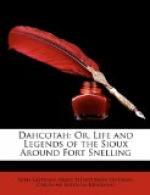When she is ready, as many presents as were given for her are collected and put on a horse; and the bride, accompanied by three or four of her relations, takes the road to the wigwam of the bridegroom.
When they arrive within a hundred yards of the wigwam, Walking Wind’s father calls for the War Club to come out. He does not come, but sends one of his relations to receive the bride. Do not suppose that Walking Wind’s father takes offence at the bridegroom’s not coming when he is called; for it is as much a part of the ceremony, among the Dahcotahs, for one of the bride’s relations to call for the bridegroom, and for the groom to refuse to come, as it is for us to have the ring put upon the third finger of the left hand.
As soon as the warrior deputed by the husband elect to receive the bride makes his appearance, the Indians raise a shout of applause, and all run towards him as he approaches them, and while they are running and shouting they are firing off their guns too.
But the ceremony is not over yet. Walking Wind, in order to complete the ceremonies, to be a wife, must jump upon the back of her husband’s relative, and be thus carried into the wigwam of which she is to be the mistress.
What a situation for a bride! Walking Wind seriously thinks of rebelling; she hesitates—while the man stands ready to start for the wigwam so soon as the luggage is on. The bride draws back and pouts a little, when some of her friends undertake to reason with her; and she, as if to avoid them, springs upon the back of the Dahcotah, who carries her into the wigwam.
But where on earth is the bridegroom? Seated on the ground in the teepee, looking as placid and unconcerned as if nothing was going on. Of course he rises to receive his bride? Not he; but Walking Wind is on her feet again, and she takes her seat, without any invitation, by the side of him, who is literally to be her lord and master—and they are man and wife. As much so, as if there were a priest and a ring, pearls and bride-cake. For the Dahcotah reveres the ceremony of marriage, and he thinks with solemn awe of the burial rites of his nation, as we do. These rites have been preserved from generation to generation, told from father to son, and they will be handed down until the Dahcotahs are no more, or until religion and education take the place of superstition and ignorance—until God, our God, is known and worshipped among a people who as yet have hardly heard His name.
SHAH-CO-PEE;
THE ORATOR OF THE SIOUX.
Shah-co-pee (or Six) is one of the chiefs of the Dahcotahs; his village is about twenty-five miles from Fort Snelling. He belongs to the bands that are called Men-da-wa-can-ton, or People of the Spirit Lakes.
No one who has lived at Fort Snelling can ever forget him, for at what house has he not called to shake hands and smoke; to say that he is a great chief, and that he is hungry and must eat before he starts for home? If the hint is not immediately acted upon, he adds that the sun is dying fast, and it is time for him to set out.




